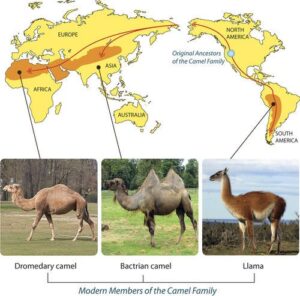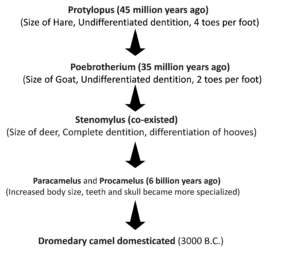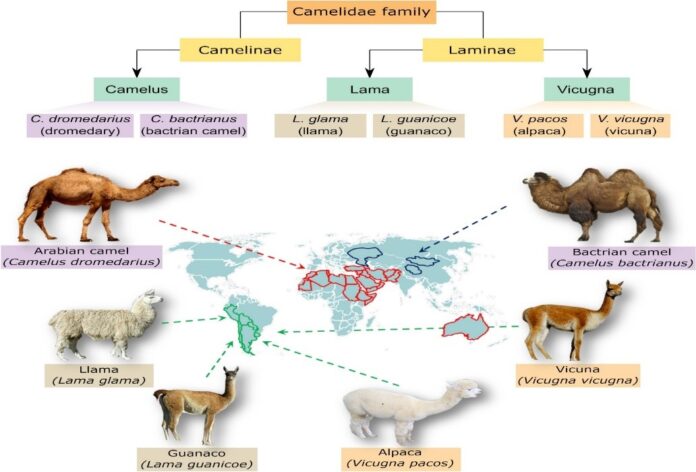Tracing the Origins: Exploring the Ancestry of Camels
Dr. Mranalini Prerna
Scientist, ICAR-National Research Centre on Camel
In this International Year of Camelids,2024, it’s pertinent to delve into the identity of camels. The term ‘camel’ encompasses all members of the Camelidae family, including both Old World Camels (OWC) and New World Camels (NWC), also known as South American camelids. The lineage of Old World Camels dates back approximately 40 million years, originating in North America before migrating to the eastern hemisphere, known as the “Old World,” via the Bering Land Bridge. Unlike some animal species such as dogs, the domestication of the dromedary camel occurred relatively late in human history, around 3000 years ago. Dromedary camels are specifically adapted to thrive in hot, arid regions of the world, particularly in the Middle East, Africa, and India, with significant feral populations found in Australia.
Camel Evolution
  |
|
Camel Distribution
Camels, renowned for their remarkable adaptability to arid environments, have a distribution that spans across diverse landscapes worldwide. From the vast deserts of Africa and the Middle East to the rugged terrains of Central Asia and the grasslands of Australia, camels have found a place in various ecosystems due to their unique physiological adaptations. In the deserts of the Arabian Peninsula and North Africa, dromedary camels (Camelus dromedarius) reign supreme. These iconic creatures are well-suited to the harsh conditions of the desert, with their ability to withstand extreme temperatures and conserve water making them invaluable companions for desert-dwelling communities.
On the other hand, Bactrian camels (Camelus bactrianus) thrive in the arid and mountainous regions of Central Asia, including Mongolia, China, and parts of Russia. With their distinctive double-humped physiques, Bactrian camels have been indispensable to nomadic herders for centuries, providing transportation, wool, and milk in these rugged landscapes. In South America, the Andean highlands are home to the alpaca (Vicugna pacos), llama (Lama glama), and guanaco (Lama guanicoe), collectively known as New World camelids. These species have been domesticated by indigenous Andean cultures for their wool, meat, and ability to navigate the challenging terrain of the Andes.
Australia boasts the largest population of feral dromedary camels in the world. Introduced in the 19th century for transportation and exploration purposes, these camels have established thriving populations in the Australian Outback, where they roam vast expanses of arid land.
The distribution of camels reflects not only their adaptability to diverse environments but also their profound cultural significance to human societies across the globe. As we continue to study and appreciate these majestic creatures, it is essential to recognize the importance of conserving their habitats and preserving the delicate balance between humans and camels in the ecosystems they inhabit.



